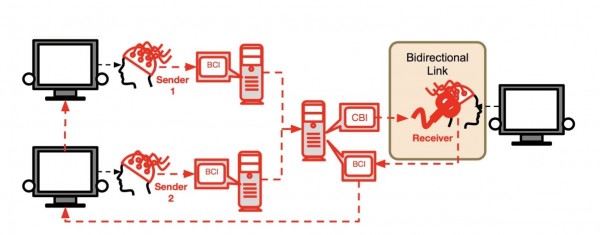The work of Andrea Stocco and his colleagues, including Chantel Prat, on BrainNet, which allows collaborative problem-solving using direct brain-to-brain communication, is the subject of this MIT Technology Review article.
Rewriting Life
The first “social network” of brains lets three people transmit thoughts to each other’s heads
BrainNet allows collaborative problem-solving using direct brain-to-brain communication.
by Emerging Technology from the arXiv, September 29, 2018
The ability to send thoughts directly to another person’s brain is the stuff of science fiction. At least, it used to be.
In recent years, physicists and neuroscientists have developed an armory of tools that can sense certain kinds of thoughts and transmit information about them into other brains. That has made brain-to-brain communication a reality.
These tools include electroencephalograms (EEGs) that record electrical activity in the brain and transcranial magnetic stimulation (TMS), which can transmit information into the brain.
In 2015, Andrea Stocco and his colleagues [including Chantel Prat] at the University of Washington in Seattle used this gear to connect two people via a brain-to-brain interface. The people then played a 20 questions–type game.
An obvious next step is to allow several people to join such a conversation, and today Stocco and his colleagues announced they have achieved this using a world-first brain-to-brain network. The network, which they call BrainNet, allows a small group to play a collaborative Tetris-like game. “Our results raise the possibility of future brain-to-brain interfaces that enable cooperative problem-solving by humans using a ‘social network’ of connected brains,” they say.
The technology behind the network is relatively straightforward. EEGs measure the electrical activity of the brain. They consist of a number of electrodes placed on the skull that can pick up electrical activity in the brain.

A key idea is that people can change the signals their brain produces relatively easily. For example, brain signals can easily become entrained with external ones. So watching a light flashing at 15 hertz causes the brain to emit a strong electrical signal at the same frequency. Switching attention to a light flashing at 17 Hz changes the frequency of the brain signal in a way an EEG can spot relatively easily.
TMS manipulates brain activity by inducing electrical activity in specific brain areas. For example, a magnetic pulse focused onto the occipital cortex triggers the sensation of seeing a flash of light, known as a phosphene.
Together, these devices make it possible to send and receive signals directly to and from the brain. But nobody has created a network that allows group communication. Until now.
Stocco and his colleagues have created a network that allows three individuals to send and receive information directly to their brains. They say the network is easily scalable and limited only by the availability of EEG and TMS devices.
Read the entire article here.

